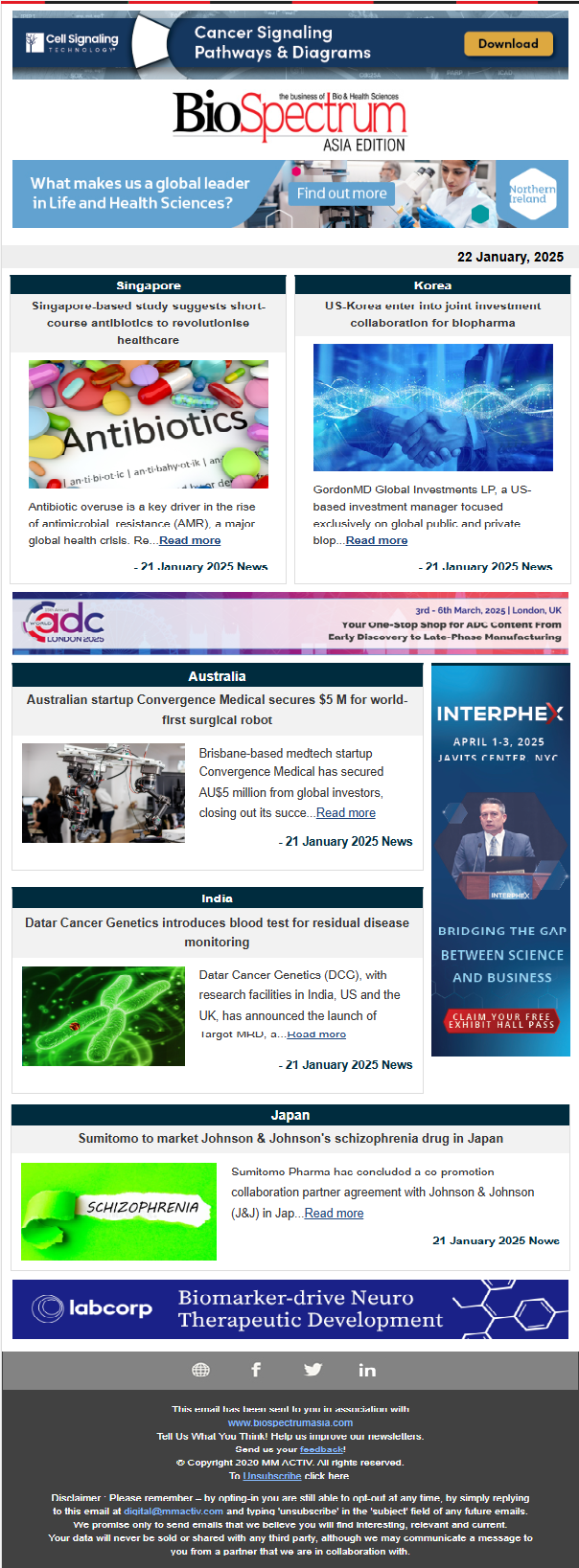
Ruch De Silva, Head of Patient & Payor Solutions and M&A Lead, DKSH
Innovation, accessibility, and global market expansion are key components of the biotechnology and pharmaceutical industries' efforts to meet steadily evolving healthcare standards. At JP Morgan's 43rd Annual Healthcare Conference held in San Francisco, CA between January 13-16, 2025, translation of cutting-edge innovations into practical solutions was the highlight. Leaders of the healthcare industry and participants discussed new opportunities to capitalize on emerging trends.
A vital aspect of Asian companies' expansion into international markets is meeting global standards and maximizing their potential. Asian enterprises are enhancing their global presence and competitiveness by adapting to international benchmarks, leveraging the latest innovations, and capitalizing on promising business models. Nevertheless, in order to achieve wider adoption of “future-proof" healthcare solutions, it is crucial to bridge the innovation-implementation gap. Thus, a value-driven approach to healthcare and biopharmaceuticals' business model deserves more attention amidst persistent challenges to healthcare accessibility. Global populations are growing and demand for value-driven healthcare approaches is increasing, a collaborative and holistic approach is crucial for bioscience and pharmaceutical industries to remain competitive in the healthcare sphere. Ruch De Silva, Head of Patient & Payor Solutions and M&A Lead, DKSH, describes key observations he made on ground at JP Morgan's conference as he navigates through biopharma and healthcare trends.
Ruch, with extensive expertise in the pharmaceutical and biotech industry, offers insight into how Asian enterprises and innovators can leverage their global presence by embracing the healthcare revolution as an opportunity to achieve global leadership.
I believe the key is to put patients first. That means identifying those who need treatment and ensuring they complete the entire course—sticking with the treatment until there’s a measurable improvement in symptoms or targeted biomarkers. In essence, the therapy must truly deliver on its promises for both the doctor and the patient. One major hurdle, however, is affordability. In some markets—take APAC for example—the prices aren’t at the level we see in more mature markets like the US, Switzerland, or Germany. This pricing challenge means that companies need to carefully evaluate and adjust their strategies. Ultimately, it’s up to the pharmaceutical companies to not only find the right patients but also to understand why patients might drop off treatment and then implement programs to help keep them engaged throughout their therapy journey.
Another area related to high-impact growth opportunities lies in bundling services around pharmaceutical products. Historically, drugs were simply chemical substances packaged in blister packs. Today, however, especially with higher-priced therapies, we are seeing drugs delivered through more sophisticated means—such as prefilled syringes or autoinjectors, often paired with monoclonal antibodies and innovative delivery devices that effectively introduce the drug into the patient's system.
Despite these advancements, the industry still lacks comprehensive service ecosystems wrapped around these products—something that's quite common in other sectors like construction equipment, automobiles, or even aircraft sales, where services are regularly bundled with the core product, such as engines or chassis.
In the pharmaceutical and medical device space, this kind of bundling is not yet widespread. However, there's a clear opportunity to integrate services that address challenges on the demand side—whether related to patients, physicians, or broader care systems. By combining pharmaceutical products and devices with tailored support services, companies can improve patient outcomes and create more impactful, value-driven growth.
Looking at the landscape, Alzheimer’s disease1 stands out as a critical area. There’s been a recent uptick in asset approvals, driven by the huge unmet need in this space—patients initially diagnosed with mild cognitive impairment can progress to moderate and severe stages, profoundly impacting their quality of life as well as that of their caregivers. Another major focus is on cardiometabolic disorders2. For example, obesity is often an early sign that can lead to a cascade of problems like hypertension, high cholesterol, diabetes, and eventually acute coronary syndromes or heart failure. These conditions call for novel therapeutic approaches that target their root causes. Additionally, in oncology, there are still certain solid tumors with significant unmet medical needs and very low five-year overall survival rates. While cancers like breast and prostate have seen remarkable progress—where patients can now live 5, 10, even 15 to 20 years post-diagnosis and often remain in remission—this is not the case for all tumor types. For example, pancreatic cancer remains a notable area where treatment options are limited and outcomes are poor. There are also a few other tumor types that fall into this category, where effective therapies are still lacking. These areas represent not only critical opportunities to improve patient outcomes but also hold significant potential impact for biopharmaceutical companies.
With global populations growing and the proportion of active labor force declining in many markets, there are rising questions about the long-term sustainability of the current pharmaceutical business model. This concern applies across all payer types—whether public, private, institutional, or out-of-pocket. We must ask ourselves: will these traditional models continue to hold up?
One major pressure point is drug pricing. Over the past 20 to 30 years, we’ve seen consistent inflation in drug prices—not just at launch, but throughout the entire product lifecycle. While the U.S. has often led this trend, similar patterns are emerging in other markets, particularly those without strong price control mechanisms.
This brings us to a critical inflection point for the industry. It may be time to explore alternative business models. One promising direction involves value-based or outcomes-based approaches, where payment is contingent upon the achievement of specific clinical results. Models like subscription-based pricing tied to measurable improvements—whether at the patient level or across a healthcare system—could offer a more sustainable path forward.
This approach fundamentally shifts the model from volume to value. It becomes an "if–then" proposition: if a patient adheres to a prescribed regimen, then we should see demonstrable outcomes—better health, improved quality of life, and more cost-effective care. Every dollar spent in healthcare should be accountable, measurable, and truly beneficial to the patient.
Gone are the days where we can accept patients taking drugs that have no clinical benefit. There have been well-documented cases where drugs had little to no impact simply because the patient’s biochemical system didn’t activate the compound properly. In such instances, it’s akin to flushing money down the drain. As an industry, we need to become much more rigorous in tracking real-world effectiveness and ensuring we are delivering true value to patients and the healthcare system at large.
To meet constantly evolving healthcare needs, the biotechnology and pharmaceutical industries must adopt a more collaborative, system-wide approach. No single stakeholder can address these challenges in isolation. While pharmaceutical companies carry a significant share of the responsibility, healthcare providers, insurers, and governments must also play an active role. Together, they need to define what sustainability looks like across therapeutic areas and implement thoughtful policies around drug pricing and access.
One major challenge is the disparity between overutilization and under-access. In some high-income markets like the U.S., we see concerning patterns—antipsychotics and opioids, for instance, are often overprescribed, leading to public health crises and unsustainable costs. Meanwhile, in low- and middle-income regions such as APAC and Africa, patients often lack access to essential medications due to regulatory delays or affordability issues.
Addressing these imbalances requires systemic reform: streamlining approval processes in underserved markets, adopting value-based pricing models, and improving adherence through innovative mechanisms like subscription-based or outcome-based care. Pharmaceutical companies should focus not only on launching new products but also on ensuring those treatments reach a broad and diverse patient population.
Another unforeseen challenge lies in ensuring patient adherence and real-world effectiveness. For chronic diseases like type 2 diabetes or HIV, success depends on patients completing their treatment regimens. That means designing systems that encourage long-term engagement, measure outcomes effectively, and deliver both clinical and economic value.
Ultimately, to keep up with healthcare’s evolving demands, the industry must transition from a product-centric model to a more patient- and outcome-centric one—where success is defined not only by innovation, but by accessibility, adherence, and impact.
This goes back to truly solving the problem at hand. The pharmaceutical and biotech industries have become very good at addressing specific clinical issues—particularly targeting molecular or biochemical pathways in the body. But the broader, more complex realities of a patient’s life often get left out of the equation. Factors such as income level, education, daily responsibilities, and access to healthcare can significantly affect treatment outcomes, yet they are rarely considered as part of the solution.
We often see therapies that perform well in a randomized clinical trial environment—where patients are highly selected and closely monitored—but fall short in the real world, where conditions are far less controlled and much more nuanced. In real-world settings, patients face day-to-day challenges that influence whether they can start, stay on, or benefit from a treatment. So it's clear that drugs alone are not enough to solve the full scope of the healthcare challenge.
We need a more holistic approach that takes into account the full context of patients' lives, including the infrastructure of the healthcare systems around them. This is especially critical in many APAC markets and other regions where healthcare delivery systems may not be equipped to ensure access and continuity of care.
The solution lies in rethinking how we define and deliver value—not just through the drug, but through support systems tailored to the needs of individual patients and markets. Of course, profitability matters, but it should be balanced with accessibility. In many developing or underfunded healthcare systems, patients simply cannot afford treatments, especially when reimbursement is limited or non-existent. Charging a uniform, pre-agreed price may not be feasible or equitable.
Alternative mechanisms such as differential pricing or income-based pricing models could help make therapies more affordable. Additionally, public–private partnerships can play a powerful role in aligning incentives, pooling capabilities, and enabling access. These collaborative models can help us tackle some of the more complex, unforeseen challenges—like affordability, distribution logistics, and health literacy—that exist outside the laboratory but directly impact patient outcomes.
Ultimately, the industry must move beyond solving biological problems alone and take a much broader view—integrating clinical innovation with socioeconomic and system-level solutions to meet real-world healthcare needs.



